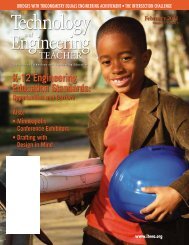Teaching Elements and Principles of Bridge Design - International ...
Teaching Elements and Principles of Bridge Design - International ...
Teaching Elements and Principles of Bridge Design - International ...
You also want an ePaper? Increase the reach of your titles
YUMPU automatically turns print PDFs into web optimized ePapers that Google loves.
FEATURE ARTICLE<br />
II. AS A GROUP, GENERATE A NEW, IMPROVED<br />
DESIGN TO BETTER FIT THE OBJECTIVE<br />
1) Evolve a new design from the group’s completed<br />
<strong>Design</strong> Cards.<br />
From the completed <strong>Design</strong> Cards <strong>of</strong> any two players,<br />
one person in the group records both double-checked<br />
designs on one <strong>of</strong> the enlarged <strong>Design</strong> Cards, where all<br />
can see, as follows:<br />
a) In Sector I, write the eyes number <strong>and</strong> the mouth<br />
letter <strong>of</strong> the first double-checked design.<br />
b) In Sector II, write the eyes number <strong>and</strong> the mouth<br />
letter <strong>of</strong> the second double-checked design.<br />
c) Draw the corresponding faces in each sector.<br />
2) Select the better design.<br />
a) Compare Faces I <strong>and</strong> II with the objective emotion.<br />
The whole group can vote on which design is<br />
better.<br />
b) Check (√) the small circle next to the better<br />
matching face.<br />
3) Evolve new designs.<br />
a) In Sector III, write the eyes number <strong>of</strong> Face I <strong>and</strong><br />
the mouth letter <strong>of</strong> Face II.<br />
b) In Sector IV, write the eyes number <strong>of</strong> Face II <strong>and</strong><br />
the mouth letter <strong>of</strong> Face I.<br />
c) Draw the corresponding faces in each sector.<br />
4) Select the better design.<br />
a) The group can compare Faces III <strong>and</strong> IV with the<br />
objective emotion <strong>and</strong> vote on which is better.<br />
b) Check (√) the small circle next to the better<br />
matching face.<br />
5) Select the best design <strong>of</strong> these image card sets.<br />
a) As a group, compare the checked faces with the<br />
objective emotion <strong>and</strong> vote on which is a better<br />
match.<br />
b) Add a second check (√√) in the small circle next to<br />
the better matching face.<br />
c) This is the best design evolved from multiple Image<br />
Card sets.<br />
6) Repeat Part II, Steps 1 through 5 with the two<br />
remaining players in the group. If there is only a<br />
single player remaining, enter only the player’s<br />
double checked selection, draw it, <strong>and</strong> check it.<br />
7) Evolve the group’s optimum match to the design<br />
objective from its card deck.<br />
With the third <strong>Design</strong> Card, summarize the previous<br />
two <strong>Design</strong> Cards in the same way <strong>and</strong>, as a group,<br />
vote to select the optimum design.<br />
III. EVOLVE THE BEST DESIGN FOR THE CLASS<br />
1) The teacher draws a <strong>Design</strong> Card on the board.<br />
2) Evolve the better <strong>of</strong> two groups’ designs.<br />
Using an overhead projector (if available), <strong>and</strong> the final<br />
best <strong>Design</strong> Cards from any two <strong>of</strong> the groups, repeat<br />
Part II to evolve the better design. The whole class can<br />
vote on which designs are better.<br />
3) Evolve the better <strong>of</strong> another two groups’ designs.<br />
Repeat Step 2 with another two groups’ best designs.<br />
4) Evolve the best design.<br />
Continue in this way evolving better designs until all<br />
groups’ designs have been “tested” <strong>and</strong> the single<br />
optimum match to the design objective has been found.<br />
IV. CHOOSE ANOTHER DESIGN OBJECTIVE<br />
Choose another design objective with a different feeling or<br />
emotion <strong>and</strong> you can evolve a totally new <strong>and</strong> different result.<br />
Find Out More<br />
The Space Technology 5 mission is part <strong>of</strong> NASA’s New<br />
Millennium Program, whose job it is to find <strong>and</strong> test out in<br />
space the new technologies that will be needed in future<br />
space missions. For more about artificial evolution, see<br />
http://ic.arc.nasa.gov/projects/esg. For more about Space<br />
Technology 5, see http://nmp.nasa.gov/st5. For an<br />
animation that helps explain how ST5’s antennas send<br />
pictures through space, go to http://spaceplace.<br />
nasa.gov/en/kids/st5xb<strong>and</strong>/st5xb<strong>and</strong>.shtml.<br />
<strong>Design</strong> Card<br />
This article was written by Diane Fisher, writer <strong>and</strong><br />
designer <strong>of</strong> The Space Place Web site at<br />
spaceplace.nasa.gov. Alex Novati drew the illustrations.<br />
Thanks to Gene Schugart, Space Place advisor, for activity<br />
concept. The article was provided through the courtesy <strong>of</strong><br />
the Jet Propulsion Laboratory, California Institute <strong>of</strong><br />
Technology, Pasadena, California, under a contract with the<br />
National Aeronautics <strong>and</strong> Space Administration.
















